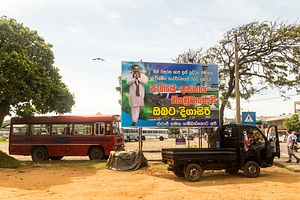In January 2015, when Maithripala Sirisena surprisingly defeated Mahinda Rajapaksa in Sri Lanka’s presidential election, the country was seemingly turning over a new chapter in its bloody recent history. In October 2018, President Sirisena’s decision to suddenly oust his prime minister, Ranil Wickremesinghe, replacing him with former strongman Rajapaksa, threw the country into a fresh constitutional crisis.
Throughout the country, particularly in the south where Rajapaksa comes from, he enjoys new widespread support. In virtually every village, dozens of large posters positively portray Rajapaksa. While president, one of Rajapaksa’s key controversial projects was the building up of Hambantota port at a cost of close to $1 billion. In December 2017, after Sri Lanka was not able to pay its debts, it agreed to hand over the port to China on a 99-year lease.
For this piece, I went there to take a look at things that were already built and what state they are in, and what is being built, and a look at the highway that will connect to the Hambantota port.
In stark contrast to Hambantota are the newer projects launched in Colombo that are transforming the face of the capital. On November 29, Sri Lanka and China signed two multimillion dollar deals for port upgrade projects in Colombo.
On December 15, seven weeks after Sirisena appointed him, Sri Lankan Prime Minister Mahinda Rajapaksa conceded that he didn’t have parliamentary support and resigned. He has since taken up the role of opposition leader.
The reinstatement of Wickremesinghe to the prime ministership and the appointment of a new cabinet means the government will once again function. But tensions remain between Sirisena and Wickremesinghe, ensuring the political crisis is not entirely over.
Out of power (again) for now, Rajapaksa, who dominated Sri Lankan politics for a decade until 2015, remains very much in the picture with widespread popular support. All the while, construction of the Hambantota port and affiliated projects continue.
Nicholas Muller is an American photojournalist and writer.





















































